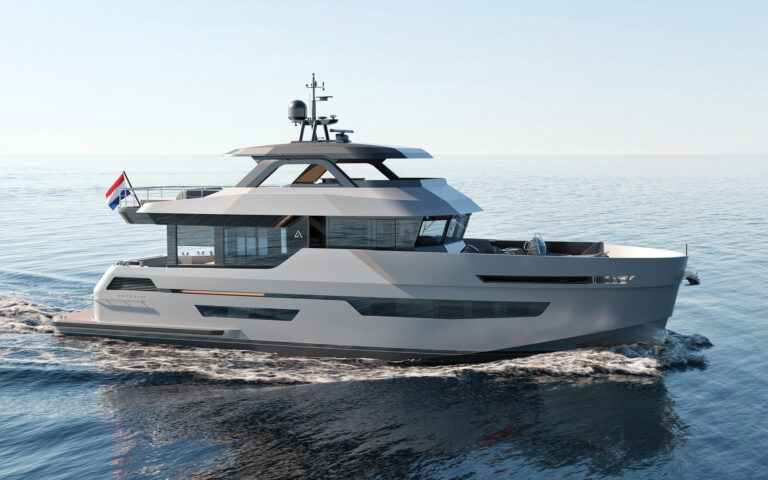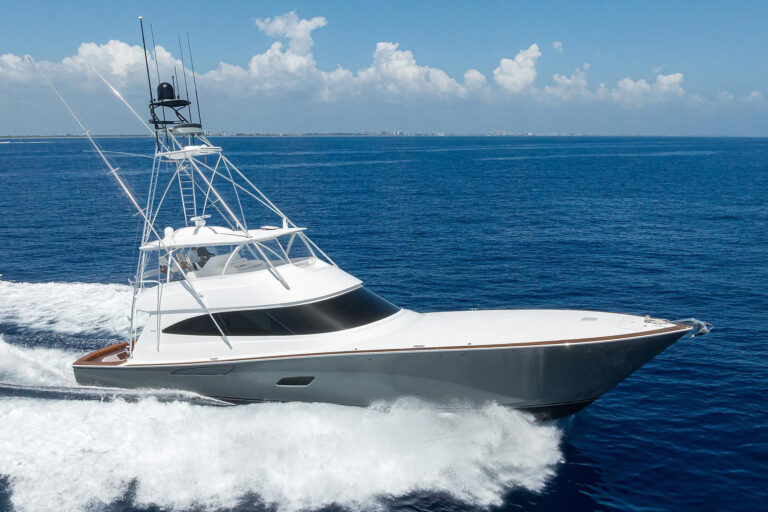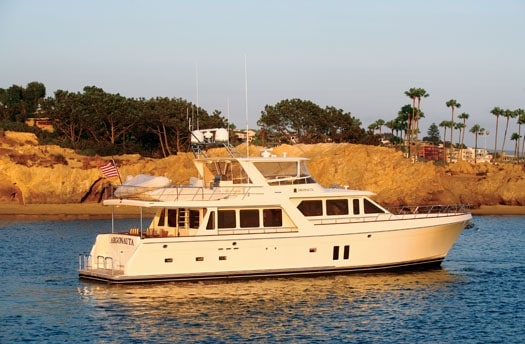
offshoreyct761.jpg
There are more than a few boatbuilders that like to boast about their years in business, but there only a few that can equal Offshore Yachts, which has a lineage dating back more than 60 years.
Wait, you say? There are several companies that can claim more than a century of boatbuilding. True enough. But many of those years were spent building in wood or metal, not fiberglass.
Remember back in the ’60s when the smug businessman took a young Dustin Hoffman aside in “The Graduate” with the advice: “I want to say one word to you. Just one word. Are you listening? Plastics.”
Offshore Yachts was listening. They trace their heritage in composite construction right back to the very first days of that newfangled material called Fiberglass Reinforced Plastic. During World War II, Offshore Yachts founder Richard Hunt helped pioneer the use of the remarkable properties of FRP in the U.S. Navy and, when the clouds of war cleared, he took that knowledge and started building some of the earliest laminated fiberglass pleasure boats.
His sons joined the business in the late ’50s and naval architect William Crealock began a long collaboration with the Hunts and Offshore Yachts in the ’60s, creating handsome lines that remain ageless.
For a company to survive, let alone succeed, for so many years is not chance: They are clearly doing something right. Having watched them for decades, I think their success is the result of two factors.
First, they’ve built a reputation for having the softest ride on the water and it’s clear that this is a major criterion in the design of every Offshore yacht. “The bottom line,” says Offshore West president, John Olson, “is that we’re willing to sacrifice speed for ride comfort.”
Bill Crealock may not be as famous as many self-promoting yacht designers, but he’s built a solid following for seakindly hulls. Take a look at an Offshore out of the water and you’ll see a deep forefoot and a mild deadrise that makes the yacht easy in a seaway. These yachts have substantial displacement and, with long keels and low centers of gravity, they were designed for owners who have extended voyaging in mind.
The second factor in the success of Offshore Yachts is their attention to detail. I guarantee that any seasoned skipper who spends some time poking into the nooks and crannies of an Offshore is going to come away impressed. I’ll share some of the items that caught my attention later, but suffice it to say that accessibility and thoughtful construction are second to none.
Some builders punch out new models like Detroit, but Offshore waits until it sees a need for a design. In this case, it was to offer amenities that weren’t available on the popular Offshore 72. The added length allows a master suite with a his-and-hers fullbeam head, it opens up space for an amidships stateroom with two berths rather than bunks, and it allows space in the salon for a formal dining table.
With wide side decks that make line handling and exterior maintenance easy, you’d expect that the salon would feel narrow, but that isn’t the case with the 76. The arrangement is flexible, with built-in settees on each side or, in the case of the boat shown, bucket chairs facing a lounge with coffee table. Clients can choose between traditional teak or mahogany interiors, or a more contemporary cherry.
Whatever the choice, the joinery is detailed and beautifully executed, from the inlaid table, to the raised-panel window mullions, to the burled valances. As you’d expect from the years that Offshore has been building yachts, every square inch of space has been turned into useful and fully finished stowage.
I’ve found that having a formal dining table, rather than just a dinette somewhere, adds the feel of a much larger yacht and, though some may argue that it wastes space, it often proves to be versatile and useful. Country kitchens are fine for casual dining, but sitting at a table makes a meal special. And the table is likely to be used for many purposes: an evening Bridge tournament, a battle of Hearts with the kids, or even a place to leave a jigsaw puzzle on a long cruise.
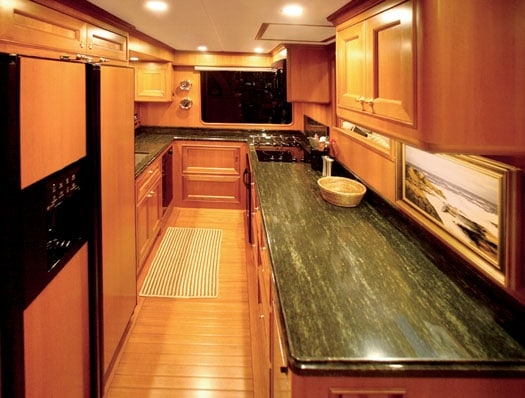
| | |
Each 76 is semi-customized to meet an owner’s needs, and one choice is whether the galley is open to the salon or separate. In this case, the enclosed galley allows a full-sized refrigerator and freezer, and the chef benefits from the wraparound counters with full backsplashes. The chef also gets a superb view with a window equal to those in the salon. The sole in the galley is an easy-to-clean, beveled planking that is a pleasant relief from the usual teak-and-holly.
The galley also shows the Offshore’s attention to detail. The beautiful granite counter has a fiddle in matching granite so that spills don’t reach the floor and sliding plates are kept on the counter. A small thing, perhaps, but thoughtful.
The pilothouse is everything you’d expect from a yacht designed for voyaging, from the flat chart drawer to the settee that converts to a pilot berth for night passages. The burled instrument panel is angled so that the skipper can easily read the three monitors from the Stidd helm chair, and a wraparound counter has the neatly arranged and backlit electrical panel. Having space for a day-head in the pilothouse is another benefit of the larger 76-footer.
When it comes to the cabin arrangements, buyers are going to have some interesting choices, starting with whether they want a private stairway to the master suite from opposite the galley. It’s definitely a big-yacht feature and perfect for those who want total privacy, turning the master suite into a retreat without having to meet guests coming or going from their own cabins. On the other hand, it uses space for a redundant stairwell, and it requires the master suite to be reversed, with the king-sized berth facing aft. Tough choice.
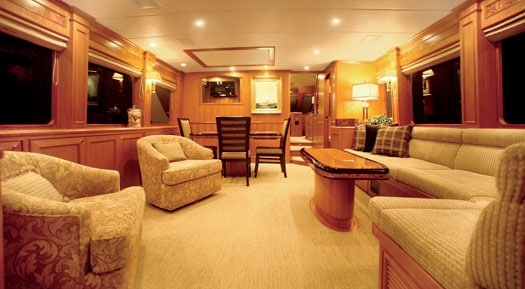
| | |
Either way, the master suite is lovely, with a pair of large windows on each side so you can look out at Bora Bora or the Pitons as you awaken. The padded headboard is recessed, nightstands are topped by sconces in burled panels, and a pair of large hanging lockers make living aboard easy.
A pair of Shoji-screened doors on each side of the berth lead into the his-and-hers heads that are separated by a large teak-grated shower.
The VIP cabin is in the bow, with a walkaround raised berth (hinged to reveal lots of stowage), twin hanging lockers, and a private head with stall shower. The guest cabin has two berths and its own head. Having all en suite heads means that no one has to run across a passageway to take a shower and, with the day-head on the main deck, guests have the luxury of leaving their toothbrushes on the counters.
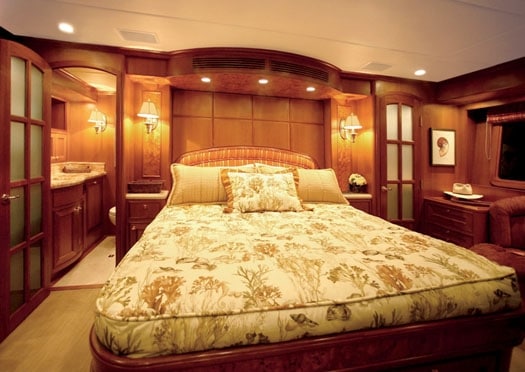
| | |
This is a pilothouse motoryacht, but I’d bet that the generously sized flying bridge is going to be the primary helm, especially if you opt for a flexible enclosure for all-weather use. Twin helm chairs are behind the molded instrument panel, which duplicates the lower station electronics. An L-shaped settee with twin tables for easy access delineate the end of the entertainment area under the hardtop, and a wet bar runs along the starboard side. Aft, the boat deck easily handles a 15-foot tender with a 2,000-pound Steelhead davit, and there’s still room for water toys plus a barbecue grill and lounge chairs.
The lower deck also has a pleasant settee with table for alfresco meals, and a wet bar in a console to port. Skippers will appreciate the full helm station on the starboard side of the afterdeck that makes short-handed docking a cinch.
The crew isn’t forgotten on the 76, either, with spacious accommodations abaft the engineroom accessible either through a watertight door on the transom or from the afterdeck. A private cabin fills the port side with upper-lower berths and a head with shower.
The opposite side of the crew area has a galley counter with sink, fridge, and microwave. There’s also a built-in workbench with tool chest and room for spares and gear.
The engineroom has clearly been designed by people who understand accessibility for maintenance. This particular 76 had the optional 1,360-horsepower MAN diesels in lieu of the standard 1,000- horsepower Caterpillar C18s but, whatever color shirt your mechanic wears, he’s going to love working here. There is, of course, a centerline walkway with Treadmaster nonslip decking and sturdy stainless steel rails for protection from hot engine parts. But even with the V-12 MAN configuration instead of the inline Cat six, there’s plenty of room outboard between the engines and the saddle fuel tanks.
This particular 76 topped out at around 21 knots but, with some propeller massaging, it’s expected to gain a knot or two and still have an efficient cruising speed of about 18 knots.
Dual Northern Lights generators are standard, with a 25 kW for day use and a 12 kW for night or backup power. Other parts of the electrical system include a Xantrex 4 kW inverter, a battery bank that includes 16 gel-cells, two 40-amp Charles Industries isolation transformers, and twin Newmar battery chargers. A Delta-T air-intake system keeps moisture out of the engineroom and a FireBoy fire system includes engine shutdowns. Here’s a nice touch: Every through-hull fitting has a label so you know exactly what it feeds.
Construction quality is high, with solid vinylester resin below the waterline, full-length and athwartships foam-filled stringers, and oversized stainless steel engine beds.
But let’s look at the really hard to see details. You know how most boats have dirty streaks down the hull because the deck drains are just notches in the cap rail? On the Offshore 76, the drains are piped internally to the waterline to eliminate those stripes.
Many builders use aluminum frames around the salon windows, but salt water turns the aluminum crusty in no time. On the 76, the frames are all molded fiberglass so they’ll look new for years.
The underside of every hatch is fully finished, and the bilge has a smooth layer of gelcoat so that every compartment, including the engineroom, can easily be cleaned. Under the foyer in the guest area is a pumproom for easy access and maintenance for the freshwater system but, more importantly, it’s been fully covered in 3M Thinsulate for noise protection so guests won’t be disturbed by running pumps.
Boarding ladders are one of those items that are either in the way or taking up valuable space in the lazarette, but not on the Offshore 76, which has a cleverly designed locker hidden in the starboard bulwark right by the boarding gate. The Marquipt three-step ladder is out of the way, but always ready for use.
If you think I liked the Offshore 76 very much, you’re right: It’s exactly the kind of boat I picture in my dreams, always with tropical beaches and a setting sun. But if you embark on your own due diligence, don’t take my word: Talk to owners of Offshore yachts. They’ll bend your ear with tales of how comfortable they are, how seakindly on voyages, how easy they are to maintain.
One of these owners made a telling comment to me: “I know I’m young enough to own several more yachts in my lifetime, but I like my Offshore so much that I know it’s going to be my last!”
He and I agree: The Offshore 76 is a keeper.
Offshore Yachts; www.offshoreyachts.net For more information, contact Offshore West, (866) 679-5290; www.offshorewest.com.







